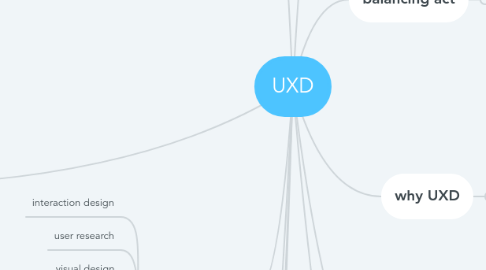
1. Activities
1.1. interaction design
1.2. user research
1.3. visual design
1.4. information architecture (IA)
1.5. front-end developement
1.6. writing / content
1.7. user testing
2. what UXD
2.1. positive user exp
2.2. value to business
2.3. responding to behaviors
2.4. evolving about product
2.5. learning about users
2.6. value to users
2.7. spot between user's need , business gold and design is on brand
2.8. usability
2.9. about users and business
2.10. business golds + user/cust goals + user interface + back end process
2.11. identify the right problem to solve
2.11.1. meet user needs and business gold
2.11.2. ensure product meet/exceed user expectation
2.11.2.1. simple
2.11.2.2. cognitive load are minimized
2.11.2.3. clear feedback for interactions
2.11.2.4. error is minimized
2.11.2.5. mistake recover quickly
2.11.3. determine the feasibility of product
3. Tools
3.1. Analytics
3.2. Competitor Benchmarking
3.3. Contextual Research
3.4. Experience Maps
3.5. Guerilla Usability Testing
3.6. Expert Review
3.7. Ideation Workshop
3.8. Information Architecture
3.9. Lab Usability Testing
3.10. Personas
3.11. Prototyping
3.12. Requirement workshops
3.13. Stakeholder Interviews
3.14. Surveys
3.14.1. not data accuracy
3.15. Task Models
3.16. Wireframes
4. A/B Testing software
4.1. tracking
4.1.1. engagement
4.1.2. clicks
4.1.3. conversions
4.1.4. sign ups
4.2. Optimizely
4.2.1. measure
4.3. just one line code
5. User Testing Software
5.1. silverback
5.2. loop 11
5.3. treejack
5.4. usertesting.com
6. technology change , people not
6.1. need visual system
6.1.1. no too many things on the screen.
6.1.2. things close together , they're related.
6.1.3. same color are related
6.1.4. red and blue are hardest color to look
6.2. make mistakes
6.2.1. prevent them
6.2.2. confirm the action if serious
6.2.3. easy to undo everything
6.2.4. tell what's wrong and what to do next
6.2.5. show me if system fix for me
6.3. cognitive limitation
6.3.1. I don't read , I scan
6.3.2. done in minute (or right now)
6.3.3. can't multi-task
6.3.4. need quidance
6.4. don't make me work or think
6.4.1. least amount of work to get the task done
6.4.2. show little information
6.4.3. show clickable
6.4.4. don't tell, show me
6.4.5. give only the stuff I need
6.4.6. system do more, I do less
6.5. Mental models
6.5.1. expectation come from experiences
6.5.2. Metaphors , eg. how to get from a to b
6.6. crave information
6.6.1. dopamine do seek information
6.6.2. often want more info than I can actually process
6.6.3. more choices feel like i'm in control , it's good
6.6.4. need feed back if system do something wrong.
6.7. like to be social
6.7.1. try to use technology to be social
6.7.2. looking to other people for guidance
6.7.3. feel indebted if you do me favor
6.7.4. show sample and I will doing it myself
6.7.5. Laughter is essential
6.8. my memory is complicated
6.8.1. always change
6.8.2. observe the action , not word
6.8.3. fragile , can make more error
6.8.4. cannot remember from one page to another
6.8.5. 3-4 things remember at a time
7. UDX honeycomb
7.1. valuable
7.1.1. useful
7.1.2. desirable
7.1.3. accessible
7.1.4. credible
7.1.5. findable
7.1.6. usable
8. balancing act
8.1. innovation
8.1.1. desirability
8.1.2. feasibililty
8.1.3. viability (can grow to versions)
9. why UXD
9.1. do little , get huge value
9.1.1. system do everything beyond expectiation
